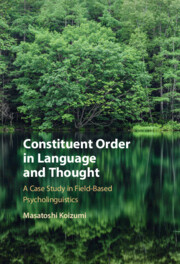Book contents
- Constituent Order in Language and Thought
- Constituent Order in Language and Thought
- Copyright page
- Dedication
- Contents
- Figures
- Tables
- Preface
- Abbreviations
- Chapter 1 Introduction
- Chapter 2 Kaqchikel Mayan
- Chapter 3 Word Order Preference in Sentence Comprehension I: Behavioral Studies
- Chapter 4 Word Order Preference in Sentence Comprehension II: fMRI Studies
- Chapter 5 Word Order Preference in Sentence Comprehension III: ERP Studies without Context
- Chapter 6 Word Order Preference in Sentence Comprehension IV: ERP Studies with Context
- Chapter 7 Basic Word Order in Language and Natural Order of Thought
- Chapter 8 Constituent Order Preference in Event Representation
- Chapter 9 Word Order Preference in Sentence Production I: Production Frequency
- Chapter 10 Word Order Preference in Sentence Production II: Time Course and Cognitive Load
- Chapter 11 Grammatical Processing and Event Apprehension
- Chapter 12 Syntactic Structure of Kaqchikel Revisited
- Chapter 13 Syntax and Processing Load
- Chapter 14 Concluding Remarks
- Book part
- References
- Index
Chapter 7 - Basic Word Order in Language and Natural Order of Thought
Published online by Cambridge University Press: 19 January 2023
- Constituent Order in Language and Thought
- Constituent Order in Language and Thought
- Copyright page
- Dedication
- Contents
- Figures
- Tables
- Preface
- Abbreviations
- Chapter 1 Introduction
- Chapter 2 Kaqchikel Mayan
- Chapter 3 Word Order Preference in Sentence Comprehension I: Behavioral Studies
- Chapter 4 Word Order Preference in Sentence Comprehension II: fMRI Studies
- Chapter 5 Word Order Preference in Sentence Comprehension III: ERP Studies without Context
- Chapter 6 Word Order Preference in Sentence Comprehension IV: ERP Studies with Context
- Chapter 7 Basic Word Order in Language and Natural Order of Thought
- Chapter 8 Constituent Order Preference in Event Representation
- Chapter 9 Word Order Preference in Sentence Production I: Production Frequency
- Chapter 10 Word Order Preference in Sentence Production II: Time Course and Cognitive Load
- Chapter 11 Grammatical Processing and Event Apprehension
- Chapter 12 Syntactic Structure of Kaqchikel Revisited
- Chapter 13 Syntax and Processing Load
- Chapter 14 Concluding Remarks
- Book part
- References
- Index
Summary
Chapter 7 turns our attention to basic word order in language and natural order of thought. In his seminal work, Greenberg (1963) observed that a vast majority of the world’s languages have one of the SO word orders as their basic word order. It is interesting to note that the distribution is heavily biased even among the three SO orders, with SOV being the most frequent, which indicates that SOV has some special status among the six possible word orders in some sense. Why should this be the case? To address this question, Goldin-Meadow et al. (2008) showed short animations depicting transitive events (e.g., a girl twisting a knob) to speakers of four languages (Chinese, English, Spanish [all SVO], and Turkish [SOV]). The participants were then asked to describe the depicted events by using only their hands, i.e., with gestures. The speakers of all four languages dominantly used the agent–patient–action order in their gestures, regardless of the basic word order of their languages. Goldin-Meadow et al. (2008: 9167) took these results to suggest that the agent–patient–action order reflects the natural sequencing of an event representation and that developing languages use it as the default pattern, thus displaying an SOV word order.
Keywords
- Type
- Chapter
- Information
- Constituent Order in Language and ThoughtA Case Study in Field-Based Psycholinguistics, pp. 66 - 74Publisher: Cambridge University PressPrint publication year: 2023

